Vermont, a New England state of the United States, is famous for its Green Mountains. These tree-covered peaks run the entire length of central Vermont. They divide the state into eastern and western sections. The beauty of the Green Mountains helps make Vermont one of the most scenic states. Every year, the mountains attract millions of skiers and other tourists. Montpelier is the capital of Vermont, and Burlington is the state’s largest city.
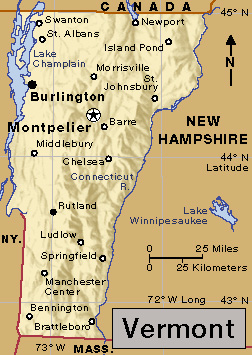
The many tourists who visit Vermont help benefit the state’s service industries. Service industries, such as retail trade and finance, combine to employ about four-fifths of Vermont’s workers. Manufacturing is also important to Vermont. Computer components are the state’s leading manufactured product.
Vermont has one of the lowest percentages of city dwellers of any state in the United States. Only three Vermont cities have more than 15,000 people. They are Burlington, Rutland, and South Burlington. Vermont has the smallest population of any state that lies east of the Mississippi River. The state ranks 49th among all the states in population. The only state that has fewer people than Vermont is Wyoming.
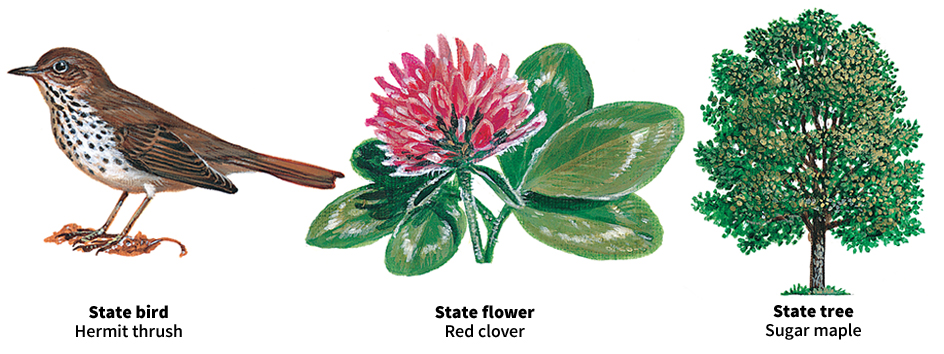
Forests cover about four-fifths of Vermont, and a variety of mineral deposits lie under the ground. These natural resources provide the raw materials for two of the state’s manufacturing industries—wood processing and stone processing. Trees from Vermont’s forests supply maple syrup, and wood for making paper, furniture, and many other products. Vermont granite and marble are used in buildings, memorials, and tombs. Slate is used for roofing and for other purposes.
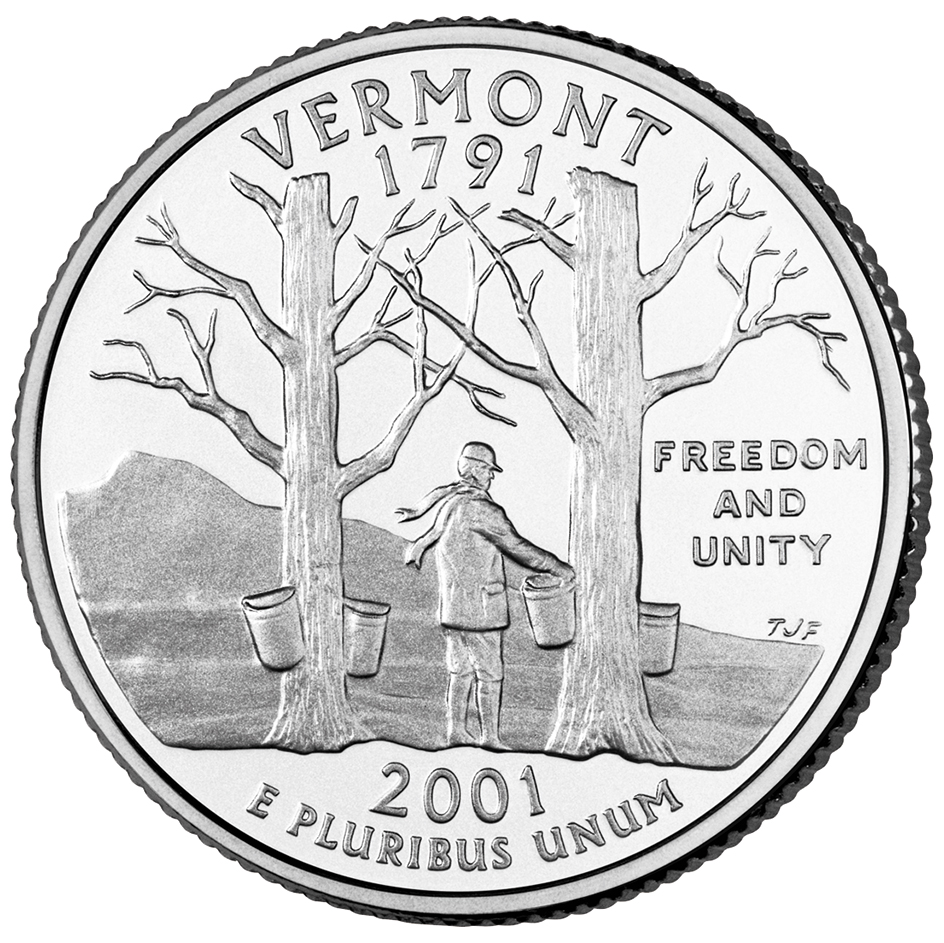
Vermont is the only New England state without a coastline on the Atlantic Ocean. However, water borders more than half the state. The Connecticut River forms Vermont’s entire eastern border. Lake Champlain extends along the northern half of the western border of Vermont. In addition to the Green Mountains, Vermont has many other mountainous and hilly areas. These include the Northeast Highlands and the Taconic Mountains.
Early in the Revolutionary War, Vermont’s Green Mountain Boys, led by Ethan Allen, gained fame for their capture of Fort Ticonderoga from the British. But Vermont was not admitted to the newly formed United States after the war. It remained an independent republic until about 10 years after the last battle. Then, on March 4, 1791, Vermont entered the Union as the 14th state. It was the first state admitted to the Union after the 13 original colonies.
During the 1850’s, Vermont began a voting record unequaled by any other state. From then until the 1960’s, the voters of Vermont chose only Republicans in elections for president and governor. They also chose Republicans in all elections for the United States Senate and House of Representatives between the mid-1800’s and the mid-1900’s. No other state has voted so many times in a row for major candidates of the same political party. Two Vermont Republicans, Chester A. Arthur and Calvin Coolidge, served as president of the United States.
The word Vermont comes from Vert Mont, the French words for Green Mountain. Vermont’s nickname is the Green Mountain State.
People
Population.
The 2020 United States census reported that Vermont had 643,077 people. The state’s population had increased 3 percent over the 2010 census figure of 625,741. According to the 2020 census, Vermont ranks 49th in population among the 50 states.
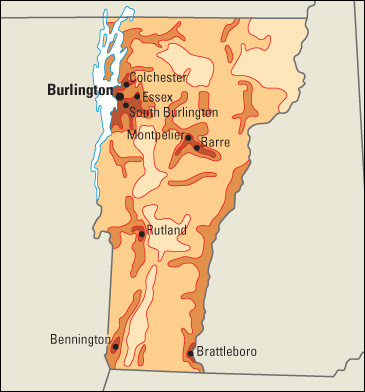
Fewer people live in Vermont than in any other state east of the Mississippi River. West of the Mississippi, only Wyoming has fewer people. However, Vermont is 11 times as densely populated as Wyoming, and has a population density higher than 19 other states. Vermont is about half as densely populated as New Hampshire, its neighbor to the east.
More than three-fifths of Vermont’s people live in rural areas. The Burlington-South Burlington metropolitan area is Vermont’s only metropolitan area. About one-third of the state’s population lives in this metropolitan area.
Burlington is the largest city in the state. It has a population of less than 45,000, but more than twice as many people as South Burlington, the second largest city. Vermont’s seven other cities, in order of size, are Rutland, Barre, Montpelier, Winooski, St. Albans, Newport, and Vergennes. Vermont has about 40 villages and 250 towns. Most towns in Vermont include small communities and rural areas.
About 94 of every 100 Vermonters were born in the United States. Vermont’s largest population groups include people of English, French, French-Canadian, German and Irish descent. Like other New Englanders, the people of Vermont have long been called Yankees. This word is used to refer to people considered to have such traits as thrift, conservative manners, reserved speech, and respect for individual rights.
Schools.
The town of Guilford voted funds for a free public school in 1761. Vermont’s constitution of 1777 required each town to have a public school. In 1780, Bennington established Vermont’s first secondary school. Vermont’s first statewide school fund was approved by the legislature in 1825. Samuel Read Hall, a pioneer educator, established the first teacher-training school in the United States at Concord in 1823.
A secretary of education and a 10-member State Board of Education supervise Vermont’s public school system. The governor appoints the secretary and the members of the board.
Local boards of directors administer Vermont’s city and town school districts. All districts belong to administrative units called supervisory unions. Some unions consist of only one large school district, but others are comprised of several smaller districts. A superintendent heads each union and works with the board or boards to manage school affairs.
Vermont law requires children between the ages of 6 and 16 to attend school.
Libraries.
Vermont’s oldest continually operating library opened in Brookfield in 1791. The Department of Libraries, in Barre, specializes in historical and legal research and reference works. The Vermont State Archives and Records Administration, in Montpelier, keeps the state’s collection of early Vermont newspapers. The David W. Howe Memorial Library of the University of Vermont, in Burlington, is the largest library in the state.
Museums.
The Vermont History Museum in Montpelier features exhibits on local history from prehistoric times to the present. It owns one of the oldest globes made in the United States. The globe was made by James Wilson in the early 1800’s. The museum also houses one of the first printing presses used in the United States.
The Bennington Museum has early American glassware, pottery, Vermont art, and historic flags. The University of Vermont’s Fleming Museum of Art in Burlington is the state’s leading museum of art and anthropology. The Saint Johnsbury Athenaeum has fine paintings. The Henry Sheldon Museum of Vermont History in Middlebury houses early Vermont documents, household furnishings, portraits, and tools. The Shelburne Museum is described in the Places to Visit section of this article.
Visitor’s guide
Vermont’s mountains, lakes, and streams offer a variety of recreational activities. Visitors to the Green Mountains can hike on the Long Trail. This footpath winds through the mountains from Massachusetts to Canada. Overnight camps lie along the trail every 6 to 8 miles (10 to 13 kilometers). In winter, tourists flock to ski resorts in the Green Mountains and other ranges. The largest ski resorts are near Jay, Manchester, Rutland, Stowe, Waitsfield, and Wilmington. The skiing season usually lasts from mid-December to mid-April. Visitors also enjoy summer boating on the larger lakes and fishing in the state’s many streams.
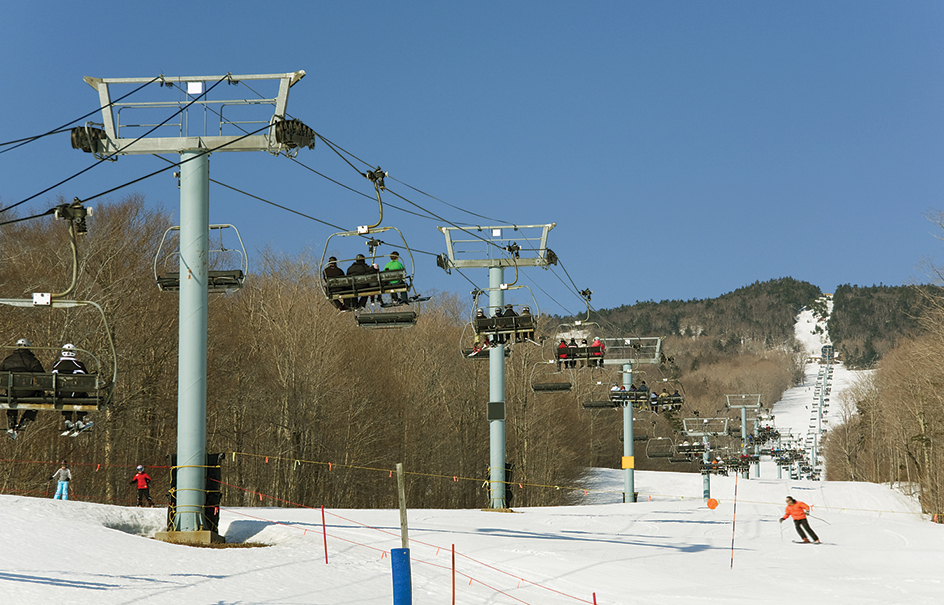
Many vacationers go to Vermont just for the beautiful scenery. In the fall, the state is ablaze with the orange, purple, red, and yellow colors of turning leaves. Vermont’s quiet towns and villages are other favorite scenes. They are noted for their white churches.
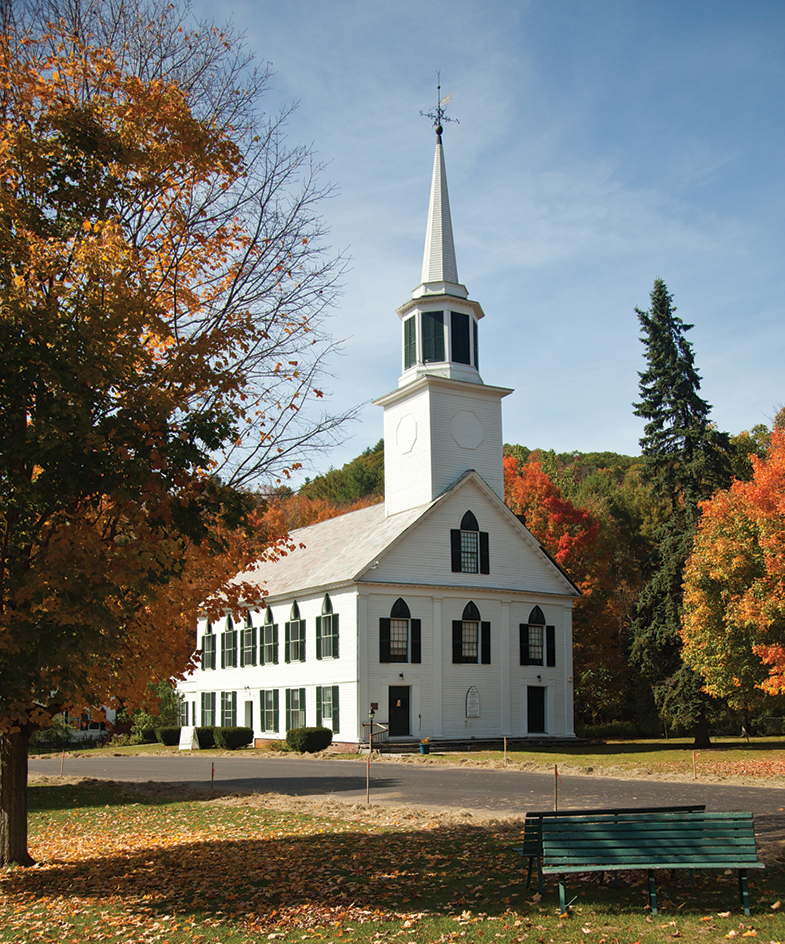
Skiing contests rank among the most popular annual events and take place in many areas during the winter. The maple sugar season begins when the winter snows start melting, usually in March. Many people gather at maple sugarhouses to watch syrup being made from maple sap. Craft fairs, antique shows, and summer theater programs are held throughout the summer. The best time to see the brilliant colors of Vermont’s autumn leaves is from mid-September through mid-October.
Land and climate
Land regions.
Vermont has six main land regions. They are (1) the Northeast Highlands, (2) the Western New England Upland, (3) the Green Mountains, (4) the Vermont Valley, (5) the Taconic Mountains, and (6) the Champlain Valley.
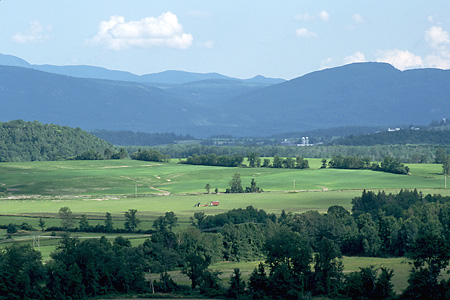
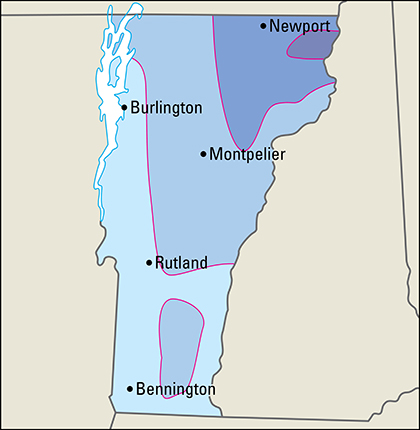
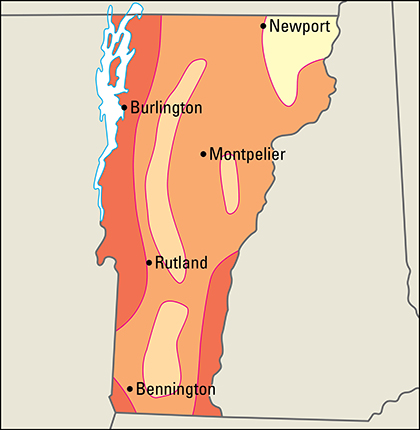
The Northeast Highlands
cover the northeastern corner of Vermont and parts of New Hampshire and Maine. This region is an area of granite similar to New Hampshire’s White Mountains. The Northeast Highlands have granite mountains that rise 2,700 to 3,300 feet (823 to 1,010 meters) above sea level. The highest are Gore Mountain (3,330 feet, or 1,015 meters), Burke Mountain (3,267 feet, or 996 meters), and Mount Monadnock (3,140 feet, or 957 meters). Swift streams cut between the mountains and flow into the Connecticut and other rivers.
The Western New England Upland
covers most of eastern Vermont. It also extends into Massachusetts and Connecticut. This region is sometimes called the Vermont Piedmont. In the east, it consists of the broad, fertile lowlands of the Connecticut River Valley. Farmers in the valley raise dairy cattle and grow apples and strawberries. The lowlands rise gradually to hills in the west. The granite hills near Barre include 1,700-foot (518-meter) Millstone Hill, also called Quarry Hill. Many lakes lie among hills in the northern part of the Western New England Upland.
The Green Mountains
region covers central Vermont. The famous Green Mountains make up all but the northeastern corner of the region. In the northeast, the Green Mountains taper off into the Northfield, Worcester, and several other low mountain ranges.
Mount Mansfield, one of the Green Mountains, is the highest peak in Vermont. It rises 4,393 feet (1,339 meters) above sea level. Killington Mountain (4,241 feet, or 1,293 meters), Mount Ellen (4,083 feet, or 1,244 meters), and Camels Hump (4,083 feet, or 1,244 meters)—all in the Green Mountains—are Vermont’s next tallest peaks. The Green Mountains region is the center of Vermont’s tourist industry. It is also an important source of minerals.
The Vermont Valley
is a narrow region that stretches about halfway up western Vermont from the Massachusetts border. The region includes the valleys of several small rivers, including the Batten Kill and the Walloomsac. Many people passed through the valley before settling in Vermont.
The Taconic Mountains
region covers a narrow strip in southwestern Vermont. The region also extends into Massachusetts. In Vermont, it includes many mountains. The highest ones are Equinox Mountain (3,816 feet, or 1,163 meters), Dorset Peak (3,770 feet, or 1,149 meters), Little Equinox Mountain (3,320 feet, or 1,012 meters), Mother Myrick Mountain (3,290 feet, or 1,003 meters), and Bear Mountain (3,260 feet, or 994 meters). Swift streams cut through the mountains, and the mountains surround many scenic lakes.
The Champlain Valley,
also called the Vermont Lowland, borders Lake Champlain. This region includes Burlington, the state’s largest city; and some of Vermont’s best farmland. The valley has many dairy farms and apple orchards. Farmers in the region also raise corn, hay, oats, and wheat on rolling hills and broad fertile lowlands. Lake Champlain has a series of islands, including Grand Isle and Isle La Motte. These islands are part of Vermont.
Rivers and lakes.
The Connecticut River forms Vermont’s entire eastern border. In 1934, a ruling by the Supreme Court of the United States gave control of the river to New Hampshire. Its western border is the low water mark on the Vermont side of the river. Otter Creek is the longest river within Vermont. It rises near East Dorset, flows 100 miles (160 kilometers) north, and empties into Lake Champlain. The Batten Kill River also rises near East Dorset. It flows south into New York.
Most other Vermont rivers run down the slopes of the Green Mountains. Some flow down the eastern slopes and empty into the Connecticut River. Others wind down the western slopes and empty into Lake Champlain. Three large rivers—the Missisquoi, the Lamoille, and the Winooski—rise east of the Green Mountains and pass through them. The rivers empty into Lake Champlain.
Vermont has about 430 lakes and ponds. Most of them are in the northeast. Lake Champlain, the largest lake in New England, covers 322 square miles (834 square kilometers) in northwest Vermont. The rest of the 490-square-mile (1,270-square-kilometer) lake lies in New York and Quebec. Vermont’s second largest lake is Lake Memphremagog. About one third of it, or 10 square miles (26 square kilometers), lies in the state, and the rest is in Quebec. Bomoseen Lake, west of Rutland, is the largest lake entirely in Vermont. It covers about 4 square miles (10 square kilometers).
Plant and animal life.
Forests cover about three-fourths of the state. Common trees include ashes, basswoods, beeches, birches, cedars, hemlocks, maples, pines, poplars, and spruces. Many kinds of ferns grow in the mountain regions of Vermont. Several types of grasses and sedges grow in the forests and lowlands. Anemones, arbutuses, buttercups, daisies, gentians, goldenrods, lilacs, pussy willows, and violets grow throughout the state.
The white-tailed deer is Vermont’s most common game animal. Fur-bearing animals found in the state include bears, beavers, bobcats, foxes, minks, moose, muskrats, raccoons, and skunks. Porcupines, rabbits, squirrels, and woodchucks live in the forests.
Climate.
Summers in Vermont are short, with few hot days. Summer nights are cool and crisp, especially in the mountains. Vermont has an average July temperature of 69 °F (21 °C). Vernon had the highest temperature that was ever recorded in the state, 105 °F (41 °C), on July 4, 1911. 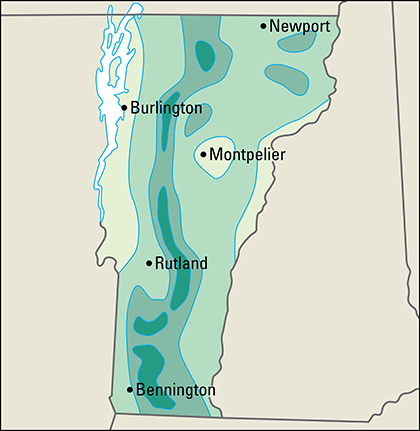
Vermont winters are long and cold, with an average January temperature of 19 °F (–7 °C). Bloomfield had the record low temperature, –50 °F (–46 °C), on Dec. 30, 1933. Snowfall in the Connecticut River Valley and the Champlain Valley ranges from 50 to 80 inches (130 to 200 centimeters) yearly. The mountains receive from 80 to 120 inches (200 to 305 centimeters) a year. Snow is important to Vermont’s economy. The deep snows on mountains attract thousands of skiers. Yearly precipitation (rain, melted snow, and other forms of moisture) averages about 42 inches (107 centimeters).
Economy
Millions of tourists visit Vermont for its tree-covered mountains and picture-postcard villages, benefiting the state’s service industries. This economic activity is also important in Vermont’s larger cities, where most of the service industries are concentrated. Manufacturing is also a major economic activity in Vermont. Computer machinery and components are among the state’s leading manufactured products. Milk is Vermont’s leading farm product, and granite is an important mined product in the state.
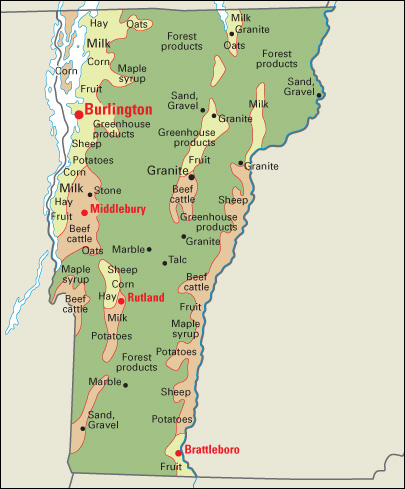
Natural resources
of Vermont include valuable mineral deposits, forests, and fertile soil.
Soil.
Vermont’s most fertile areas are its river valleys. Some parts of the state are rocky with little or no soil.
Forests
cover about four-fifths of Vermont. The state’s hardwood trees include ashes, birches, beeches, maples, and oaks. Softwood trees include cedars, hemlocks, red and white pines, and spruces.
Minerals.
Large granite, marble, slate, and talc deposits make the Green Mountains region Vermont’s chief mining area. Valuable marble deposits are also found in the Vermont Valley and the Taconic Mountains. Much of Vermont’s slate comes from the Taconic Mountains. Granite is found in eastern Vermont.
Service industries,
taken together, account for the majority of both Vermont’s employment and its gross domestic product—the total value of goods and services produced in the state in a year. Most of the service industries are concentrated in Burlington, Montpelier, and Rutland, and also in popular tourist centers.
Montpelier, the state capital, is the center of government activities. Burlington is the chief financial center. Many of the hotels, restaurants, and retail trade establishments are also in the Burlington area. Ski resorts dot the Green Mountains. Many people in New York and Massachusetts have vacation homes in Vermont. 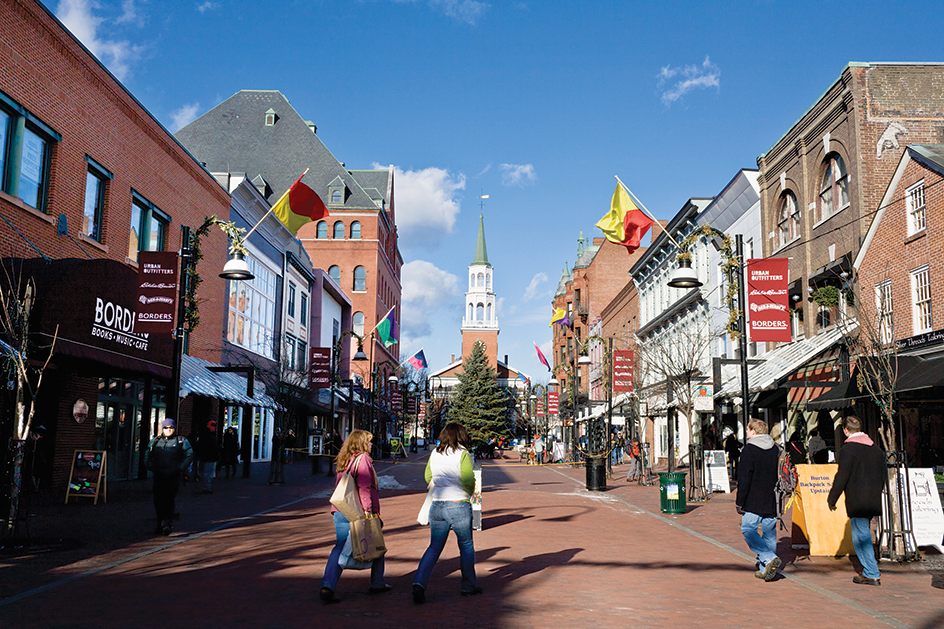
Manufacturing.
The production of electronic equipment is one of Vermont’s leading manufacturing activities. Semiconductors are the most important product of this industry. IBM, one of the world’s largest electronics companies, has a large plant in the Burlington area that makes computer components.
Dairy products provide about half of the income for Vermont’s food-processing industries. Dairy products are primarily produced in Franklin and Washington counties. Bakery goods, chocolate products, and meat products are also produced in the state.
Vermont’s fabricated metal products and machinery manufacturing are centered in the Burlington area. Leading fabricated metal products include guns, machine shop products, and sheet metal. Wood products are mainly produced in the southern half of the state. Other leading manufactured products include chemicals and medical equipment.
Agriculture.
Farmland covers about a fifth of Vermont’s land area. Dairy farming accounts for over half of Vermont’s annual farm income. Many of the state’s dairy farms lie in the Champlain Valley of northwestern Vermont. Farmers also raise beef cattle, chickens, sheep, and other livestock throughout the state.
Vermont is the leading state in producing maple syrup. Specialty food products, such as cheese and ice cream, contribute significantly to Vermont’s agricultural economy. Sweet corn ranks as the leading vegetable, and apples as the leading fruit. Corn, hay, and oats are grown as animal feed. Greenhouse and nursery products are an important source of income. 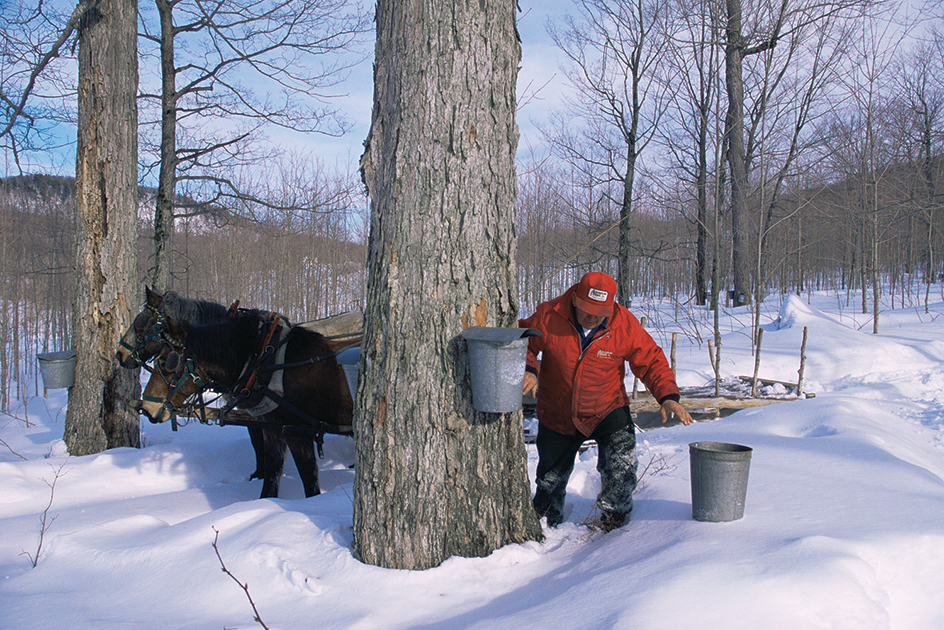
Mining.
Crushed stone is Vermont’s leading mined product. Limestone is the leading crushed stone product. Granite is mined in the Barre area. Other products mined in Vermont include sand and gravel and talc.
Electric power and utilities.
Hydroelectric power accounts for about half of Vermont’s electric power. Most of the state’s remaining electric power comes from other renewable energy sources and from plants that burn wood.
Transportation.
Vermont has an extensive system of roads and highways. Interstate 89 and Interstate 91 are the chief highways. Interstate 89 extends northwest from White River Junction to the Canadian border at Highgate. Interstate 91 runs north and south between Guilford and Derby Line. The historic, scenic Ethan Allen Highway, also known as U.S. Route 7, is popular with tourists. It extends between Bennington in the south and the Canadian border, near Lake Champlain, in the north. Vermont’s chief airport is at Burlington.
Communication.
The Vermont Gazette was published in Westminster for a brief period, beginning in 1780. The Rutland Herald is Vermont’s oldest continuously published newspaper. It was begun as a weekly in 1794 and is now a daily. The Burlington Free Press and the Rutland Herald are the state’s largest dailies.
Government
Constitution
of Vermont was adopted in 1793. Vermont had two earlier constitutions, adopted in 1777 and 1786. The Constitution of 1777 was the most liberal of its time. It gave all adult male citizens the right to vote, without regard to their race or religion, or whether or not they owned property. It also forbade slavery.

Amendments (changes) to the Constitution may be proposed every four years by a two-thirds vote of the state Senate. The proposed amendments must be approved by a majority vote in the state House of Representatives. At the next legislative session two years later, the amendments require approval by a majority of both the House and the Senate. Finally, to become law, amendments need the approval of a majority of the people who vote on the proposals in an election.
Executive.
The governor is elected to a two-year term. The governor may be reelected any number of times. Voters also elect the lieutenant governor, attorney general, auditor, secretary of state, and treasurer to two-year terms. The governor appoints most other top officials, with Senate approval.
Legislature
of Vermont is called the General Assembly. It consists of a 30-member Senate and a 150-member House of Representatives. The voters in each of Vermont’s 16 senatorial districts elect from one to three senators, depending on total population. Voters in each of 109 representative districts and subdistricts elect one or two representatives, depending on voter population. Senators and representatives serve two-year terms. The legislature is scheduled to meet in odd-numbered years but usually meets in even-numbered years as well. Its sessions begin on the first Wednesday after the first Monday in January. 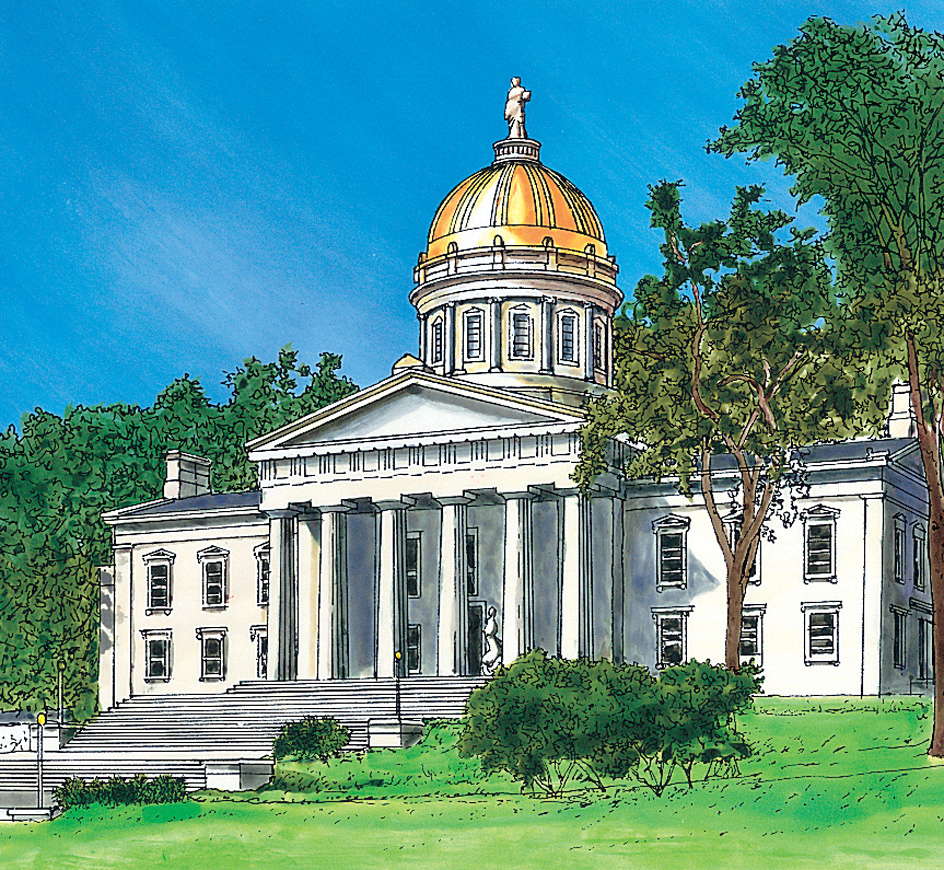
Courts.
The Supreme Court, Vermont’s highest court, has a chief justice and four associate justices. Supreme Court justices are appointed to six-year terms by the governor from a list of candidates submitted by a judicial nominating board. After a justice has served six years, the General Assembly votes to retain or dismiss the justice. Superior Court and District Court judges serve six-year terms. These judges are selected and retained in the same way as Vermont Supreme Court justices. Each county has one or two Probate Courts, whose judges are elected to four-year terms.
Local government
in Vermont is centered in towns. Vermont towns are similar to townships in other states. That is, they are geographic areas that may include several communities and large rural districts under one government. In Vermont, there are about 240 towns with local governments. Five towns—Averill, Ferdinand, Glastenbury, Lewis, and Somerset—do not have enough inhabitants to have governments. They range in population from 2 people in Lewis to 21 in Averill. Each of Vermont’s ten cities also has a local government.
Vermont towns use the town meeting form of government, the purest type of democracy, in which citizens take a direct part in government. Each March, town voters assemble to elect officials, approve budgets, pass laws, and decide other local business. Vermont cities operate under council-manager or mayor-council governments. Cities, towns, villages, and special districts must submit changes in their charters to the Vermont General Assembly for approval. The powers of county governments are limited mainly to judicial affairs. 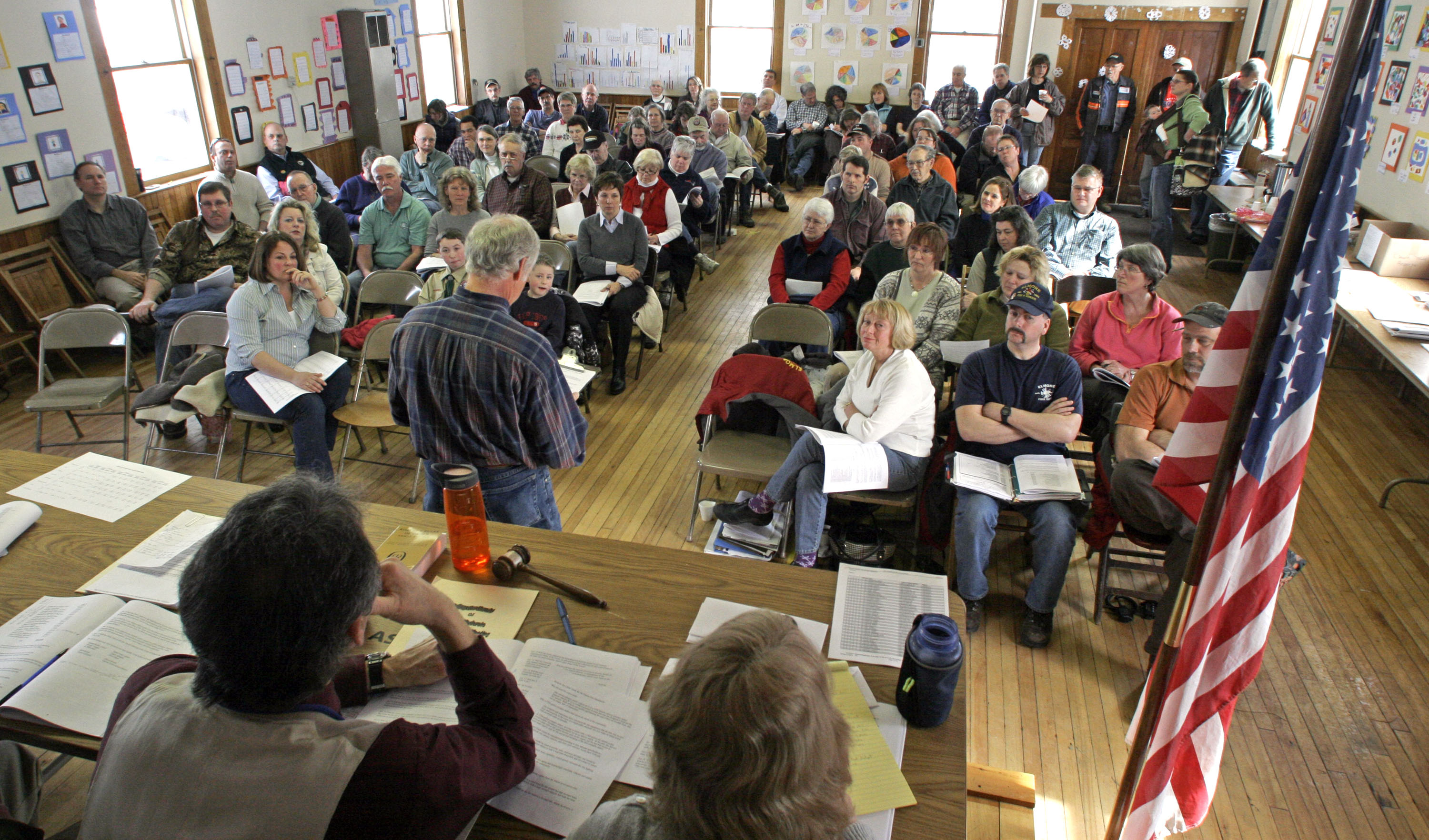
Revenue.
Taxes account for about half of the state government’s general revenue (income). Most of the rest comes from federal grants and other programs of the United States government, and from charges for government services.
A personal property tax accounts for the greatest portion of the tax revenue. Other important sources of tax revenue include a personal income tax, general sales tax, and taxes on motor fuels, motor vehicle licenses, corporate incomes, and insurance premiums.
Politics.
Vermont’s electoral votes went to the Republican candidate in every presidential election from 1860 through 1960. Since then, however, the state has voted for the Democratic candidate in several presidential elections (see Electoral College).
All of Vermont’s governors from 1854 until 1963 were Republicans. Since then, both Democrats and Republicans have won the office of governor several times. In 1974, Patrick J. Leahy became the first Democrat to be elected to the U.S. Senate from Vermont since the early 1800’s.
History
Early days.
Vermont was chiefly an Indigenous (native) peoples’ hunting ground before European settlers came. The Europeans called the Indigenous people Indians. The Abenaki, Mahican, and Penacook tribes of the Algonquian group first claimed the region. Tribes of the powerful New York Iroquois people drove the Algonquian out. The Algonquian returned during the early 1600’s. With help from the French, they defeated the Iroquois.
Exploration and settlement.
Samuel de Champlain of France was probably the first white person to explore what is now Vermont. He arrived at Lake Champlain in 1609, and claimed the Vermont region for France. In 1666, the French built a fort dedicated to Saint Anne on Isle La Motte in Lake Champlain. In 1690, Jacobus de Warm led British soldiers from Albany, New York, to a point near the site of present-day Middlebury, Vermont. De Warm founded a fort at Chimney Point, west of Middlebury. Vermont’s first permanent white settlement was made at Fort Dummer, in what is now Brattleboro. Fort Dummer was built by Massachusetts settlers in 1724 to protect that colony’s western settlements from raids by French and Indigenous fighters.
The Lake Champlain region became a major battleground during the French and Indian War (1754-1763). In this war, England gained from France the control of Vermont and much of the rest of North America. See French and Indian wars.
Land disputes.
Benning Wentworth, the royal governor of New Hampshire, made 131 grants of Vermont land between 1749 and 1763. This land was called the New Hampshire Grants. But New York claimed the same land and granted it to other settlers. In 1764, England recognized the grants made by New York. England ordered settlers who held New Hampshire Grants to surrender their land or pay New York for it. In 1770, these settlers organized a military force called the Green Mountain Boys to defend their land. The Green Mountain Boys attacked many New York settlers and drove them from Vermont. See Green Mountain Boys.
The American Revolution
began in Massachusetts in 1775, before the Vermont land disputes were settled. Vermonters united to fight the British. Ethan Allen, Benedict Arnold, and more than 80 Green Mountain Boys captured Fort Ticonderoga from the British in May 1775. Colonial troops held the fort until 1777, when the British drove them out. The troops retreated south from Fort Ticonderoga, with the British in pursuit. In Hubbardton, a rear guard led by Seth Warner stopped the retreat and fought the British. The rear guard was defeated. But the fighting delayed the British long enough to allow the rest of the colonists to escape. 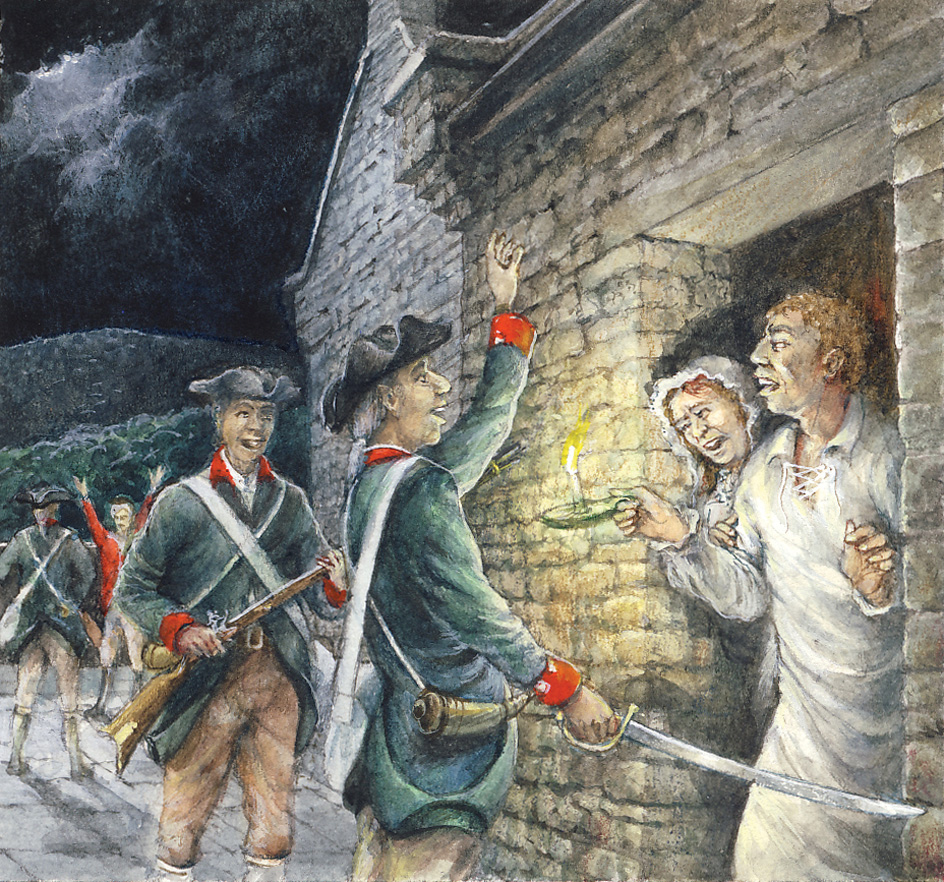
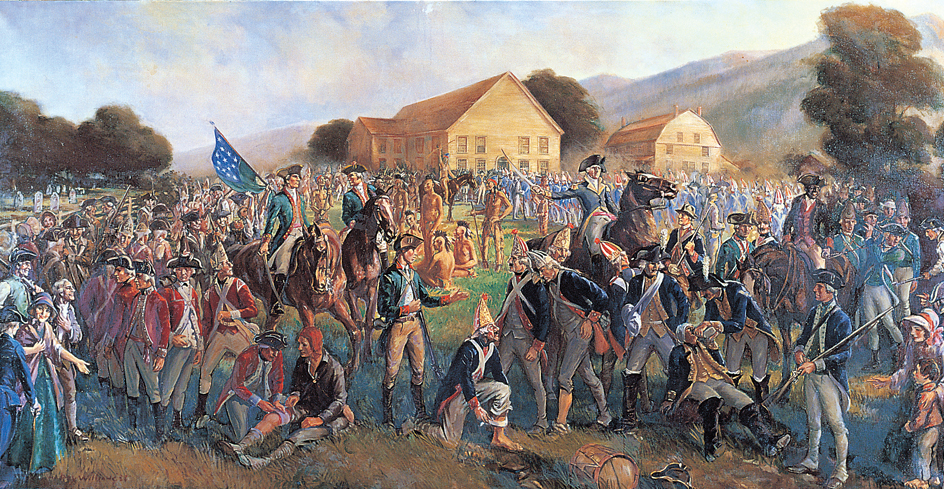
The Battle of Bennington, on Aug. 16, 1777, was a major Revolutionary War conflict. It is often thought of as a Vermont battle. But it was actually fought just west of Vermont, in New York. The Battle of Bennington and the British surrender at Saratoga (also in New York) marked the end of British land operations in the Northern Colonies.
Independent republic.
On Jan. 15, 1777, Vermont settlers declared their territory an independent republic. They named it New Connecticut. In July 1777, Vermont adopted its first constitution and its present name.
New Hampshire and New York still claimed parts of Vermont. But Vermont ignored the claims. In 1783, George Washington wrote that he believed it would be necessary to send troops to overthrow the Vermont government. But this never happened, and Vermont remained an independent republic for 14 years. In 1790, Vermont settled its dispute with New York by paying it $30,000. New Hampshire also gave up its claim to Vermont. Such improved relations helped clear the way for Vermont’s admission to the Union. On March 4, 1791, Vermont became the 14th state. 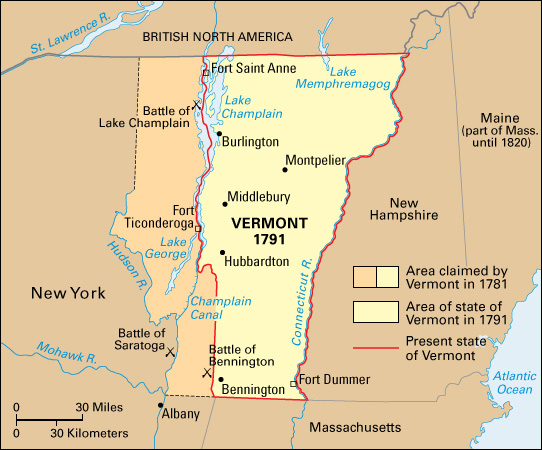
The 1800’s.
During the War of 1812, Vermont volunteers fought the British in the battles of Chippewa and Lundy’s Lane, and the Battle of Lake Champlain, near Plattsburgh, New York. But the war was unpopular in Vermont, because trade with British-controlled Canada had become important to the state’s economy. In 1817, after a harsh winter, many people began to move from Vermont to the growing Midwest. Some feared future economic hardships in Vermont. Others were attracted by the great opportunities to the west.
The Champlain Canal, which opened in 1823, connected Lake Champlain and New York’s Hudson River. The canal allowed Vermont farmers to ship their goods by water all the way to New York City, a major market. Farmers in the Champlain Valley prospered, especially those who raised Spanish Merino sheep for wool. By 1840, Vermont had six times as many sheep as people. Many small, water-powered mills were built in Vermont to process the wool from the sheep. During the mid-1800’s, competition from Western states and other countries made wool prices drop. By 1860, Vermont farmers had sold half their sheep to be used as meat. This crisis caused Vermont to change from a sheep-raising state to a dairy-farming state. 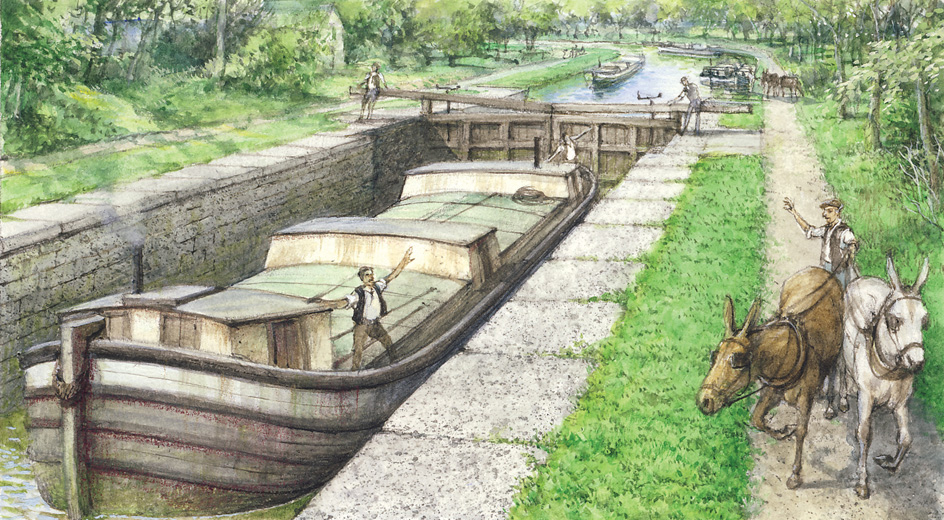
During the Civil War (1861-1865), about 34,000 Vermonters served with the Union forces. The northernmost land action of the war took place in Vermont in 1864. A group of 22 Confederate soldiers raided banks in St. Albans, and fled to Canada with over $20,000.
Agriculture declined in Vermont after the war. More and more Vermont farmers left the state for cities, or for better farmland in the Midwest and elsewhere. Most of the French Canadians and Europeans who moved to Vermont settled in cities to work in factories. The late 1800’s brought great growth to Vermont’s wood-processing and cheese-making industries. Burlington grew rapidly as a port city that processed lumber from Canada and shipped it to other cities in the United States. The granite industry boomed in Barre. Vermont’s once important textile industry declined during the late 1800’s. Many textile mills moved to the South, where labor costs were lower.
The early 1900’s.
The value of Vermont’s manufactured products more than tripled between 1900 and 1920. Manufacturing replaced agriculture as Vermont’s most important economic activity.
Vermont’s tourist industry also grew rapidly during the early 1900’s. Many large resort hotels and vacation camps were built. In 1911, Vermont became the first state with an official publicity bureau to attract tourists.
In 1923, Calvin Coolidge, born in Vermont, became the 30th president of the United States. He had been elected vice president under President Warren G. Harding, who died in office. Coolidge was a shy man who was quiet in public. To many people, he seemed to be a “typical Vermont conservative.”
The nationwide Great Depression of the 1930’s brought severe hardship to Vermont. Many small factories and lumber mills closed. Vermont farmers were hurt by falling prices and reduced sales. Vermont’s economy improved during the late 1930’s.
The worst flood in Vermont history occurred in November 1927. Waters from the Winooski River and branches of the Connecticut River swept away entire sections of towns. The flood caused 60 deaths and millions of dollars in damage.
The mid-1900’s.
During World War II (1939-1945), Vermont factories produced war materials. After the war, the state increased its efforts to attract new industries. The Vermont Development Department, established in 1949, promoted industrial development and tourism. The state’s Municipal Bond Act of 1955 gave Vermont communities permission to issue revenue bonds. Money from the bonds financed industrial construction programs.
During the 1960’s, a few large corporations built factories in Vermont. But most of the industry attracted to Vermont would be considered small in many other states. An interstate highway from Massachusetts to the Canadian border, developed during the 1960’s, contributed to the growth of industry and tourism in Vermont.
As Vermont manufacturing grew, agriculture became less important to the state’s economy. Farms decreased in number and increased in size, and the population began to shift from rural to urban areas.
Politically, Vermont remained a Republican center of strength. Republicans held such control in the state that the election of a few Democrats in the 1950’s and 1960’s made national news. William H. Meyer, elected to the U.S. House of Representatives in 1958, became the state’s first Democratic member of Congress since 1853. Philip H. Hoff, who served as governor of Vermont from 1963 until 1969, was the first Democrat to hold that office since 1854.
From 1856 through 1960, Vermont gave the state’s electoral votes to the Republican Party nominee in every presidential election. In 1964, the electoral votes of the state were given to the Democratic Party nominee, Lyndon B. Johnson.
The late 1900’s.
The Democratic Party steadily continued to gain strength in Vermont. In 1974, Patrick J. Leahy became the first Democrat to be elected to the United States Senate from Vermont since the early 1880’s. Following Hoff, other Democrats won election as governor. In 1984, Madeleine M. Kunin became the first woman to be elected governor of Vermont. In the 1992 and 1996 presidential elections, the state’s electoral votes were given to the Democratic nominee for only the second and third times. Bill Clinton carried the state then.
Manufacturing and tourism continued to contribute greatly to Vermont’s economy. The tourist industry, centered in the Green Mountains, brought large sums of money to the state. But some manufacturing and tourist activities were a concern to Vermonters who strongly supported maintaining the state’s rural environment. In 1970, the legislature passed the Environmental Control Law. This law, one of the strictest of its kind, allows the state to limit major developments that could harm the environment. It has been used to prevent potentially damaging projects.
Recent developments.
The greatest challenge facing Vermont today lies in balancing the competing expectations between the people who favor development and their opponents. The economic benefits of development regularly clash with the desire to maintain Vermont’s rural character and natural beauty.
In 1999, in a landmark decision, the Vermont Supreme Court ordered the state government to offer homosexual couples the same rights and benefits as heterosexual couples. In 2000, the Vermont legislature approved a bill that allowed couples of the same sex to enter into a civil union, a legal relationship similar to a marriage. In 2009, the legislature went further and overrode Governor Jim Douglas’s veto of a bill allowing same-sex couples to marry. Vermont thus became the first state to legalize gay marriage by a law rather than by a court ruling.
In August 2011, heavy rains from Tropical Storm Irene caused extensive flooding in the state. Overflowing rivers damaged hundreds of roads, dozens of bridges, and many homes and businesses. In July 2023, another powerful storm caused heavy flooding in many areas of Vermont. The flooding damaged thousands of homes and many roads and bridges.
